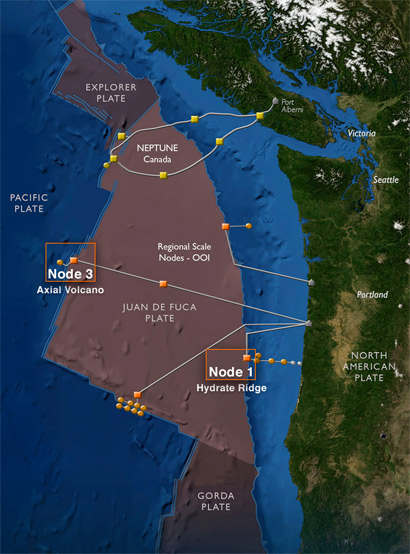OOI Mapping Cruise 2008
Regional Scale Nodes
The Regional Scale Nodes will extend continuous high-bandwidth (tens of Gigabits/second) and power (tens of kilowatts) to a network of many different types of instruments widely distributed across, above, and below the seafloor in the northeast Pacific Ocean
Cabled Underwater Research Facility
The University of Washington is leading the effort to develop the Regional Scale Nodes (RSN) component of the National Science Foundation's Ocean Observatories Initiative. This cabled underwater research facility will be constructed in the northeast Pacific Ocean off the coasts of Oregon and Washington.
World’s First
The RSN, together with the University of Victoria's NEPTUNE Canada network, will form the world's first ocean observatory to span a tectonic plate. The facility will provide a constant stream of data in real time from throughout the water, on the seafloor, and below the seafloor associated with the Juan de Fuca tectonic plate.
Why the Northeast Pacific Ocean?
A representative suite of the natural phenomena that occur throughout the world's oceans and seafloor also occur in, on, and above the Juan de Fuca tectonic plate, one of a dozen or so major plates that make up the surface of the Earth. Scientists will investigate locally such global processes as major ocean currents, active earthquake zones, creation of new seafloor,and rich environments of marine plants and animals.
Nodes
There will be five nodes on the main cable. Nodes are located in sites of highest scientific interest and will function as “outlets” on the seafloor where power, as well as communications connectivity, will be brought from shore via cable and will be available to instruments, sensors, and robots. This cruise focuses on mapping areas around locations of Node 1 (Hydrate Ridge) and Node 3 (Axial Volcano).
